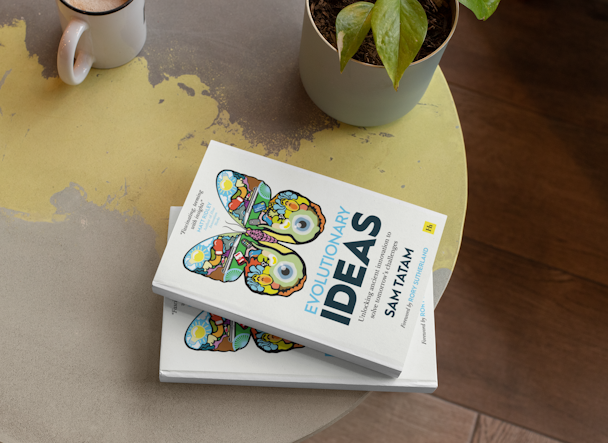Innovation evolved: Q&A with Sam Tatam, author of Evolutionary Ideas
This week, Ogilvy’s head of behavioral science Sam Tatam has released a book called Evolutionary Ideas. Looking at five of the biggest challenges facing businesses today, the book looks at innovation as an “evolutionary phenomenon.” Brands, he argues, just need to look to nature if they want to level up their change strategies. Here, he gives us an exclusive Q&A on the book’s genesis and what its lessons mean for marketers.

Ogilvy’s Sam Tatum explains his thoughts behind new book Evolutionary Ideas
What inspired you to write this book?
In 1997, the 500-Series Japanese bullet trains sped into service. Compared to its predecessor, it was significantly faster and quieter, and consumed 15% less electricity on the open track.
While it’s easy to assume these developments were a result of moonshot innovation and advances in physics, the story of the 500-Series is one harnessing the Darwinian wisdom of evolved biology; specifically, the biology of the owl, the Adelie penguin and the kingfisher. Instead of making a faster, quieter and more efficient train by starting from a blank slate, the engineers borrowed from these evolved solutions to address the challenges they faced. It was a story of biomimicry.
Advertisement
The philosophy of biomimicry is simple. After billions of years, failures are fossils, and that which has remained is the secret for survival. Today, while fields such as engineering, design and architecture borrow heavily from evolved biological solutions to accelerate innovation, this approach is also relevant when exploring evolved psychological solutions. The more our ancestors made decisions that increased their chances of survival, the more likely it became for these underlying mechanisms to be passed on. While we might not appreciate it, evolution is all around us.
I wrote this book to illuminate the vast opportunities the field of behavioral science and evolutionary psychology offers contemporary innovation. Challenging the view that innovation is the result of lone mavericks, rare visionaries and flashes of inspiration, as with the field of biomimicry, today we can also borrow from a rich array of ideas that have simply evolved around us. We can breed new ideas from those that already exist.
Evolutionary Ideas helps us spend less time developing expensive and high-risk solutions and more time embracing and imaginatively executing psychological solutions that have been road-tested over time. In the same way birdwatching unlocked innovation for the 500-Series, we can now clearly spot and apply evolved ideas readily and rapidly.
Advertisement
Why is Evolutionary Ideas relevant in 2022?
There are many reasons we need Evolutionary Ideas now more than ever.
Every day there is increasing pressure on organizations to innovate and find new ways of solving problems. Evolutionary Ideas not only identifies how (often less expensive) psychological solutions can create competitive advantage; it also, maybe more importantly, shows how we can borrow from other fields not typically seen as relevant to our own category or industry. It exposes new ways to leapfrog our competition to solve some of the problems we’re all faced with today.
Secondly, there’s a clear need to be more efficient in our decision-making and approach to innovation. Many organizations continue to pursue costly, high-risk innovation processes. In many instances, we’re rolling the dice. Why start from scratch looking for a magical spark in a dark garage when evolutionary ideas help us innovate by providing a shortlist of places to start? While not a silver bullet, the book helps us focus our search for inspiration by starting with existing ‘evolved’ ideas, expediting problem-solving with a more sustainable approach to innovation.
Finally, this is a book designed to accelerate progress in critical fields. Whether staying committed to a course of antibiotics, returning for a second dose of vaccination, or triggering small actions such as switching off the lights, there are small things that we can be doing to make big changes. And, once again, the solution to these challenges aren’t necessarily hidden within the most obvious industry or field. The answer to the question may well lie elsewhere.
Suggested newsletters for you
Who is the book for – and in what sectors, and areas of the business?
Evolutionary Ideas is for problem-solvers.
While I work in the creative field, it’s not just a book for advertisers or marketing departments (although it’s extremely useful there). Its aim is to provide prompts for people looking to solve old problems in new ways (or indeed, new problems in old ways).
By identifying patterns of evolved solutions across disparate domains and industries, you will be armed with entirely new frames of reference and the ability to connect ideas that would otherwise never meet. While you might inform public policy, manage internal stakeholders or sell TVs, we all face similar psychological challenges every day.
This book shares the foundations of a systematic model of psychological innovation. You will learn how to apply this thinking to solve five of the most fundamental challenges faced in business, innovation and behavior change. Whether this is helping to reinforce trust, aid decision-making, trigger action, boost loyalty or improve experiences, this is a book for you.
You will learn that revolutionary ideas are expensive and rare. They take years to develop and have a terrible reputation for failure. Alternatively, every day, someone, somewhere, is facing the very same challenge as you. Evolutionary Ideas helps you to see and creatively reapply these opportunities to out-innovate your competition.
Content by The Drum Network member:

Ogilvy UK
Ogilvy is all about depth and breadth - we have London's broadest and deepest skillset in communications our award-winning teams work fluidly across our core capabilities...
Find out more
